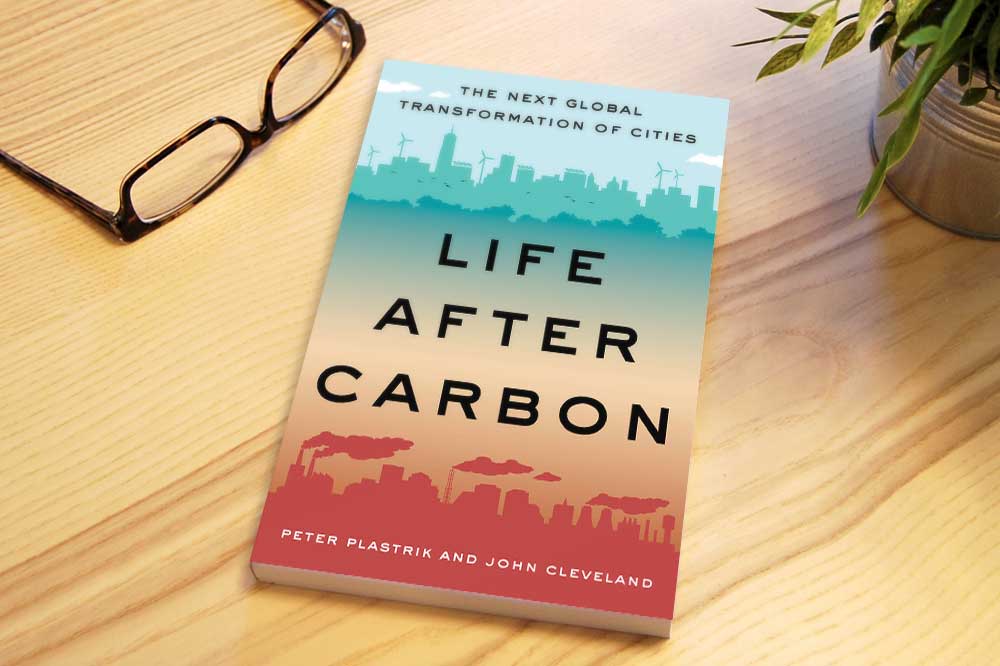
By Sadhu Aufochs Johnston
More and more local governments around the world are rising to the climate change challenge. Many are pushing to decarbonize their energy, building, transport, and waste systems and developing their resilience to the rise in sea levels and extreme precipitation and heat.
For the past 17 years, I have been deeply involved in the efforts of two cities—now, as city manager for Vancouver, British Columbia, and before that, as Chicago’s chief environmental officer. These cities are both global leaders in addressing climate change. More importantly, they are using their innovative efforts to make themselves into better places to live, work, and play.
Early in 2019, our newly elected council joined hundreds of other cities from around the world to declare a Climate Emergency. In April of this year, it unanimously approved an ambitious set of next steps intended to align Vancouver’s work with efforts to limit global warming to 1.5 degrees. That call to action is a recommitment to taking steps to be a global leader, as well as confirmation that we must act now to protect our communities from the rapidly changing climate.
In Vancouver, we have used the commitment to taking action to help drive our economic growth. We have partnered with entrepreneurs to develop a fast-growing, job-creating “green economy” business sector, and we are home to 20 percent of Canada’s clean-tech companies. Jobs and population in our community have each grown by more than a third since 1990, while our carbon emissions have decreased in that same time by about 7 percent.
Vancouver has successfully branded itself as a highly desirable place for young, innovative talent to find work and build companies. A 2015 study by Brand Finance, based in Toronto, found that Vancouver has one of the strongest brands, valued at $31 billion, and that the city is uniquely associated with being clean, green, and environmentally sustainable.1
Three Lessons for Local Governments
In my close work with mayors and councils, city departments, business community leaders, environmental activists, community-based leaders, universities, philanthropies, urban planners, architects, engineers, and residents, I’ve learned three lessons about how local governments can take action and have a significant impact in addressing climate change.
1. Innovate, innovate, innovate.
When local governments began to tackle climate change, no one knew how much they could do. It was assumed that national governments would have the greatest impact. But it turns out that cities and counties can do, and have done, much more than anyone imagined possible. The Global Covenant of Mayors has carbon-reducing commitments from more than 9,000 local governments with 800 million residents. More than 600 cities around the world measured and reported their emissions to CDP (www.cdp.net/en) and disclosed more than 8,000 urban sustainability actions.
In Vancouver, we are working toward achieving our goal to be 100 percent renewably powered before 2050 by reducing our energy usage and switching from fossil fuels to renewable energy sources such as wind, solar, and hydropower. The largest source of carbon pollution is burning natural gas for space and water heating in buildings, so with strong support of council and the community, we have put in place a world-pioneering Zero Emission Building Plan for all new construction to ensure that new buildings are energy efficient and use no fossil fuel by 2030.
We struggled with the fact that we don’t control the sources of that energy, so we built Canada’s first sewer heat recovery system that harvests heat from a significant sewer line to provide heat to a neighborhood, thereby enabling residents and businesses to reduce their carbon emissions by 70 percent. To produce our own renewable energy, we are harvesting methane from the landfill and partnering with FortisBC, our gas utility, to clean the gas and put it into the fossil gas distribution system. Each of these solutions required taking an innovative approach to our challenges.
2. Connect, connect, connect.
Back in 2008, while in Chicago, I was charged with addressing the rising summer heat using green technologies, but I didn’t know which cities and counties I could learn from, so I helped to start a peer-to-peer network, the Urban Sustainability Directors Network (USDN, www.usdn.org) to find out what people in other cities were doing—to get the inside scoop, the questions and failures, not just the messages for public consumption.
And it worked: USDN now has more than 200 city and county members in North America. The city-to-city information sharing and collaboration have been extraordinarily robust and inspiring, and in 2018 the network members identified 14 high-impact “must do” practices for local governments.2 I was learning so much from that network of North American cities that five years ago I helped to start another peer-cities network, the Carbon Neutral Cities Alliance (CNCA, carbonneutralcities.org), of 20 vanguard cities in 10 countries that are global leaders in decarbonization.
CNCA had the same purpose: Share inside information about innovations and collaborate on research and experiments. Many other city-based networks, such as C403 and 100 Resilient Cities4 have been started in just the past decade. All of them demonstrate the great value that is created when cities exchange information and insights and band together to learn, collaborate, and advocate. In the twenty-first century, no city alone can fully address the challenges of decarbonization and strengthening climate resilience.
3. Embrace bold, transformational ideas and vision.
It’s critical for cities to have a clear vision about where they want to go. These visions are built on ideas about what cities can and should be. As mentioned earlier, Vancouver’s city council has declared that we will be 100 percent renewably powered by 2050. It’s hard to imagine a city without the noise and pollution that comes from burning gas and diesel, but we are more than 30 percent of the way there already, and our plan will get us there.
In the process, we are using demonstration projects, neighborhood working groups, clean-energy conferences, and social-media campaigns to inspire our residents and businesses. The big ideas underpinning this vision—a green city, a competitive city, a renewable-energy city, an equitable city—are bold because they are quite different from the ideas on which most modern cities have been built. They represent a radical change in our thinking about what Vancouver and other cities can become—and these ideas for urban transformation are taking hold across the globe. Of course, this work must be done with a strong lens on equity to ensure that everyone, especially low-income people and traditionally under-represented people, are involved with and can benefit from these changes.
Life After Carbon
Vancouver is not alone in following this ambitious pathway. Cities large and small, wealthy and poor, on every continent are innovating and connecting in response to climate change. The vigor, impact, and transformational direction of this urban movement has been fully documented in a book, Life After Carbon: The Next Global Transformation of Cities by Peter Plastrik and John Cleveland (Island Press, 2018).
The authors look closely at 25 cities worldwide—including Austin, San Francisco, Copenhagen, London, Shanghai, Melbourne, Cape Town, Mexico City, and, yes, Vancouver—and explain how they have become “climate innovation laboratories” at the leading edge of systemic urban change. These cities “have come to understand themselves, their place in the world, in a new way and act boldly on their changed awareness.”
The book describes the rise and impact of a global urban “Rebel Alliance.” It’s a network of networks; a new urban capacity of countless city officials, community activists, professionals, corporate leaders, scholars, and others--“a self-organizing, tireless swarm with no commander-in-chief, following the ‘North Star’ of climate action.”
Most usefully, Life After Carbon identifies four big transformative ideas that are at the heart of the many climate innovations cities have developed—and shows how these ideas are being applied worldwide. In this set of new ideas, cities are understood to be primary drivers of:
- Economic innovation and growth, meaning they can turn the world’s emerging renewable-energy economy into business and jobs.
- Environmental quality, human health, and social inclusion—values that reach beyond an economic standard of living.
- Restoration of nature inside and outside of cities; turning back to nature to provide environmental, social, health, and economic benefits.
- Preparation for and adaptation to uncertainties and risks in ways that build civic capacity and social cohesion.
“Gradually,” note the authors, “transformational ideas are becoming a new standard for cities—not just a toolbox of innovations but a radically different way of thinking about, a model for, city development and urban achievement around the world.”
Plastrik and Cleveland know what they are talking about—having worked in and alongside many cities. They helped to build the USDN and CNCA networks and have written insightful reports about cities’ climate innovations. Life After Carbon presents an inspiring account of actual urban change that could not have been written just 10 years ago; there simply wasn’t enough going on then.
But today, the story of cities’ transformative journeys makes compelling reading for local government leaders everywhere. My experiences in Vancouver and Chicago and in various city-based networks have taught me that, as Life After Carbon puts it, “The successor to the modern city is busy being born.”
If your council is considering declaring a climate emergency and getting in on this action, I urge you to pick up a copy of this book to see what other cities are doing and how they’re doing it.

Endnotes and Resources
1 https://vancouver.ca/news-calendar/brand.aspx
2 https://www.usdn.org/public/page/137/USDN-High-Impact-Practices
3 https://www.c40.org/
4 https://www.100resilientcities.org/
New, Reduced Membership Dues
A new, reduced dues rate is available for CAOs/ACAOs, along with additional discounts for those in smaller communities, has been implemented. Learn more and be sure to join or renew today!
